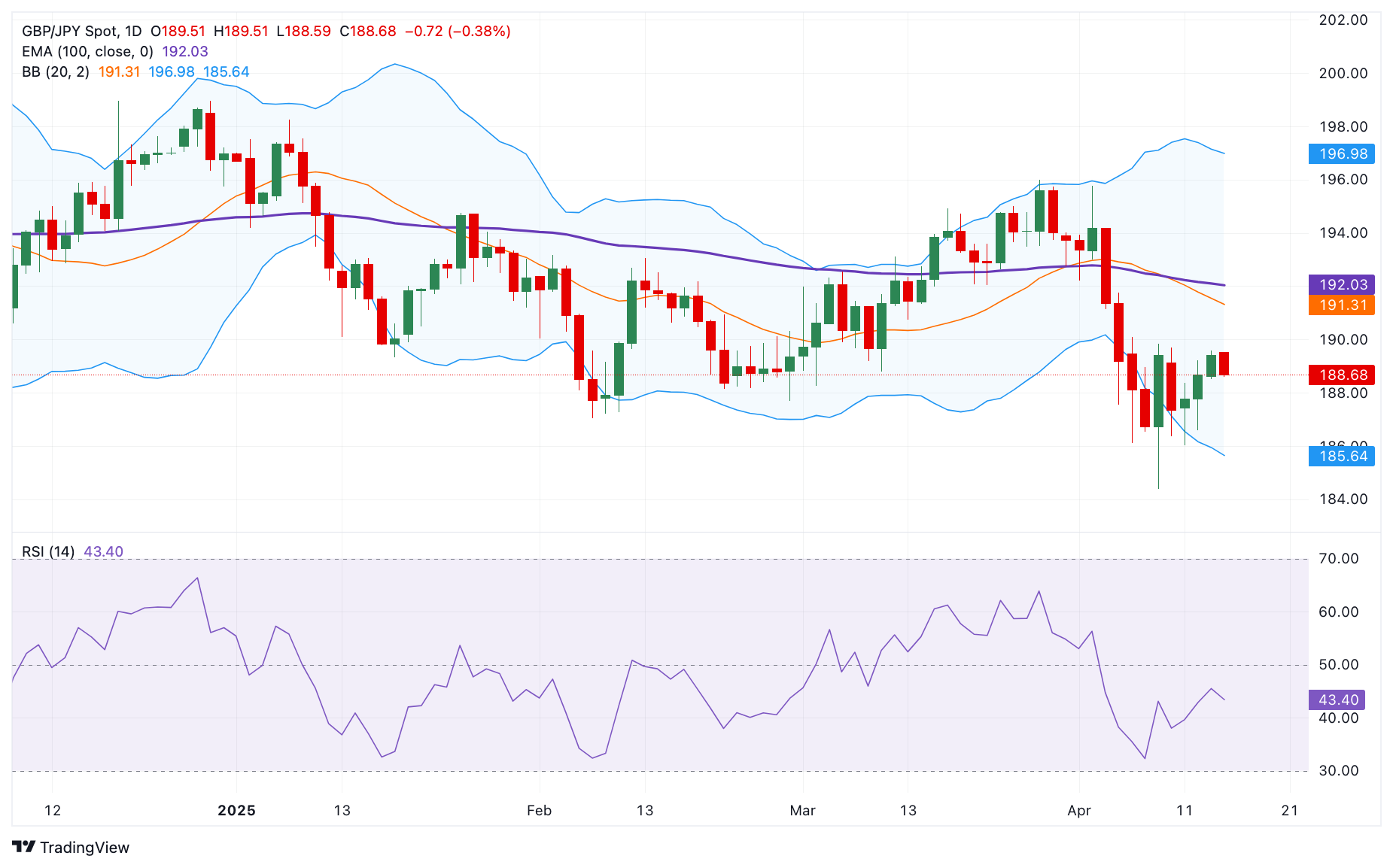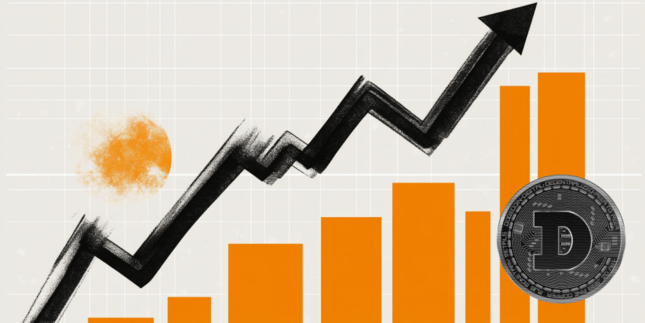- GBP/JPY softens to near 188.80 in Wednesday’s early European session, down 0.31% on the day.
- The cross keeps the negative outlook below the 100-day EMA with a bearish RSI indicator.
- The initial support emerges at 186.55; the crucial upside barrier is located at 190.00.
The GBP/JPY cross attracts some sellers to around 188.80 during the early European session on Wednesday. The Pound Sterling (GBP) weakens against the Japanese Yen (JPY) after the UK Consumer Price Index (CPI) inflation report.
The UK Consumer Price Index (CPI) rose 2.6% YoY to March, an easing from the 2.8% increase in February, according to the Office for National Statistics on Wednesday. It was the weakest inflation since December 2024 and below the market consensus of 2.7%. Meanwhile, the Core CPI, which excludes the volatile prices of food and energy, rose 3.4% YoY in March versus 3.5% prior, in line with the market consensus of 3.4%.
According to the daily chart, the bearish outlook of GBP/JPY remains in play as the cross remains capped below the key 100-day Exponential Moving Average (EMA). Furthermore, the downward momentum is supported by the 14-day Relative Strength Index (RSI), which is located below the midline near 44, suggesting that the path of least resistance is to the downside.
The first downside target for the cross emerges at 186.55, the low of April 8. Extended losses could see a drop to 185.65, the lower limit of the Bollinger Band. A decisive break below the mentioned level could pave the way to 184.37, the low of September 13, 2024.
On the bright side, the immediate resistance level for the cross is located at the 190.00 psychological mark. Sustained trading above this level could attract some buyers to 192.05, the 100-day EMA. Further north, the next hurdle is seen at 194.19, the high of April 3.
GBP/JPY daily chart

Pound Sterling FAQs
The Pound Sterling (GBP) is the oldest currency in the world (886 AD) and the official currency of the United Kingdom. It is the fourth most traded unit for foreign exchange (FX) in the world, accounting for 12% of all transactions, averaging $630 billion a day, according to 2022 data. Its key trading pairs are GBP/USD, also known as ‘Cable’, which accounts for 11% of FX, GBP/JPY, or the ‘Dragon’ as it is known by traders (3%), and EUR/GBP (2%). The Pound Sterling is issued by the Bank of England (BoE).
The single most important factor influencing the value of the Pound Sterling is monetary policy decided by the Bank of England. The BoE bases its decisions on whether it has achieved its primary goal of “price stability” – a steady inflation rate of around 2%. Its primary tool for achieving this is the adjustment of interest rates. When inflation is too high, the BoE will try to rein it in by raising interest rates, making it more expensive for people and businesses to access credit. This is generally positive for GBP, as higher interest rates make the UK a more attractive place for global investors to park their money. When inflation falls too low it is a sign economic growth is slowing. In this scenario, the BoE will consider lowering interest rates to cheapen credit so businesses will borrow more to invest in growth-generating projects.
Data releases gauge the health of the economy and can impact the value of the Pound Sterling. Indicators such as GDP, Manufacturing and Services PMIs, and employment can all influence the direction of the GBP. A strong economy is good for Sterling. Not only does it attract more foreign investment but it may encourage the BoE to put up interest rates, which will directly strengthen GBP. Otherwise, if economic data is weak, the Pound Sterling is likely to fall.
Another significant data release for the Pound Sterling is the Trade Balance. This indicator measures the difference between what a country earns from its exports and what it spends on imports over a given period. If a country produces highly sought-after exports, its currency will benefit purely from the extra demand created from foreign buyers seeking to purchase these goods. Therefore, a positive net Trade Balance strengthens a currency and vice versa for a negative balance.
Information on these pages contains forward-looking statements that involve risks and uncertainties. Markets and instruments profiled on this page are for informational purposes only and should not in any way come across as a recommendation to buy or sell in these assets. You should do your own thorough research before making any investment decisions. FXStreet does not in any way guarantee that this information is free from mistakes, errors, or material misstatements. It also does not guarantee that this information is of a timely nature. Investing in Open Markets involves a great deal of risk, including the loss of all or a portion of your investment, as well as emotional distress. All risks, losses and costs associated with investing, including total loss of principal, are your responsibility. The views and opinions expressed in this article are those of the authors and do not necessarily reflect the official policy or position of FXStreet nor its advertisers. The author will not be held responsible for information that is found at the end of links posted on this page.
If not otherwise explicitly mentioned in the body of the article, at the time of writing, the author has no position in any stock mentioned in this article and no business relationship with any company mentioned. The author has not received compensation for writing this article, other than from FXStreet.
FXStreet and the author do not provide personalized recommendations. The author makes no representations as to the accuracy, completeness, or suitability of this information. FXStreet and the author will not be liable for any errors, omissions or any losses, injuries or damages arising from this information and its display or use. Errors and omissions excepted.
The author and FXStreet are not registered investment advisors and nothing in this article is intended to be investment advice.
Recommended content
Editors’ Picks

EUR/USD drops below 1.1400 after Germany and EU PMI data
EUR/USD struggles to hold its ground and trades below 1.1400 in the European session on Wednesday. PMI data from Germany and the Eurozone showed that the business activity in the service sector contracted in April. Markets await comments from central bankers and US PMI data.

GBP/USD stays weak near 1.3300 after disappointing UK data
GBP/USD stays under bearish pressure near 1.3300 in the European session on Wednesday. Pound Sterling struggles to find demand following the weaker-than-forecast April PMI data from the UK. BoE Governor Bailey will speak later in the day and the US economic calendar will feature PMI reports.

Gold price takes it on the chin after Trump softens tone on trade and Fed
Gold price is undergoing some profit-taking and sees selling pressure on Wednesday towards $3,300 at the time of writing. The profit taking picked up on comments from United States President Donald Trump, who did a 180-degree turn on his stance on China and the Federal Reserve (Fed). After the closing bell, Tesla’s (TSLA) Chief Executive Officer Elon Musk said he will reduce his role at the Department of Government Efficiency.

Dogecoin lead double-digit gains across meme coins, with Shiba Inu, PEPE and BONK skyrocketing to new monthly highs
Top meme coins Dogecoin, Shiba Inu, PEPE and BONK lead the meme coin sector with double-digit gains on Wednesday following the crypto market recovery.

Five fundamentals for the week: Traders confront the trade war, important surveys, key Fed speech Premium
Will the US strike a trade deal with Japan? That would be positive progress. However, recent developments are not that positive, and there's only one certainty: headlines will dominate markets. Fresh US economic data is also of interest.

The Best brokers to trade EUR/USD
SPONSORED Discover the top brokers for trading EUR/USD in 2025. Our list features brokers with competitive spreads, fast execution, and powerful platforms. Whether you're a beginner or an expert, find the right partner to navigate the dynamic Forex market.



